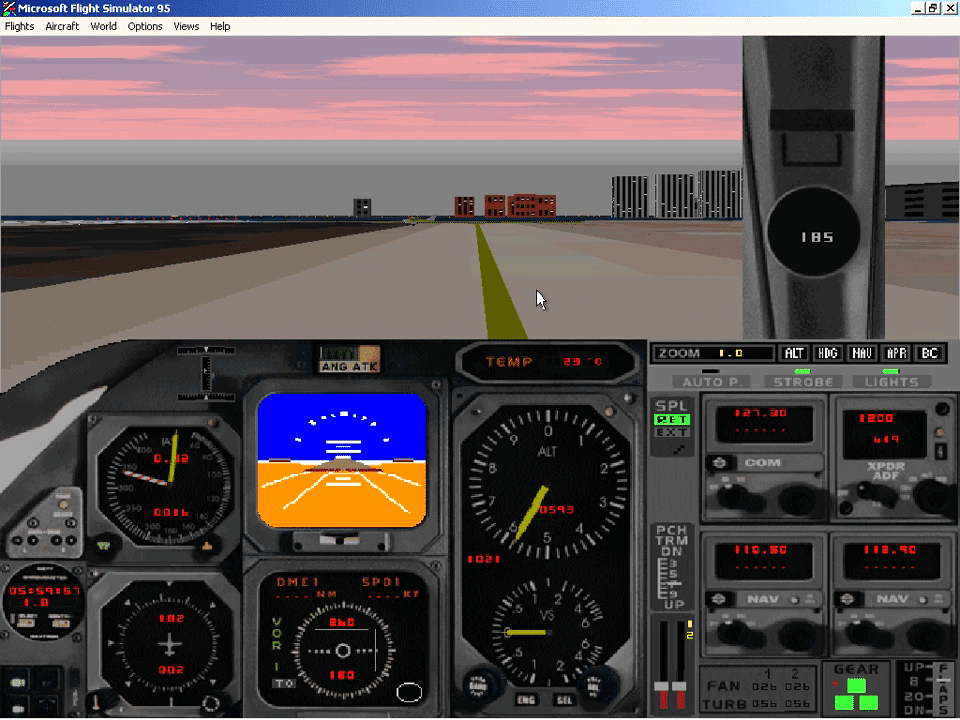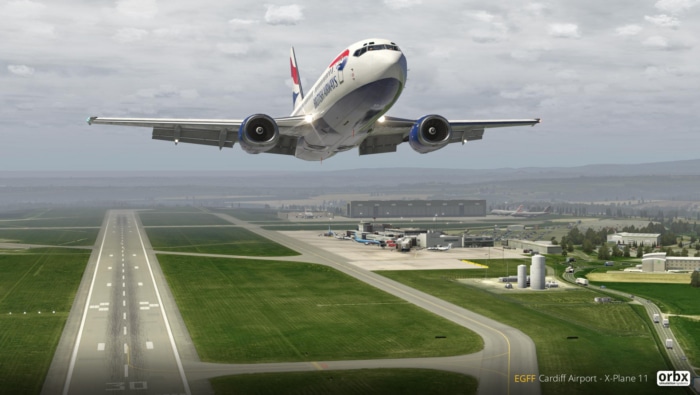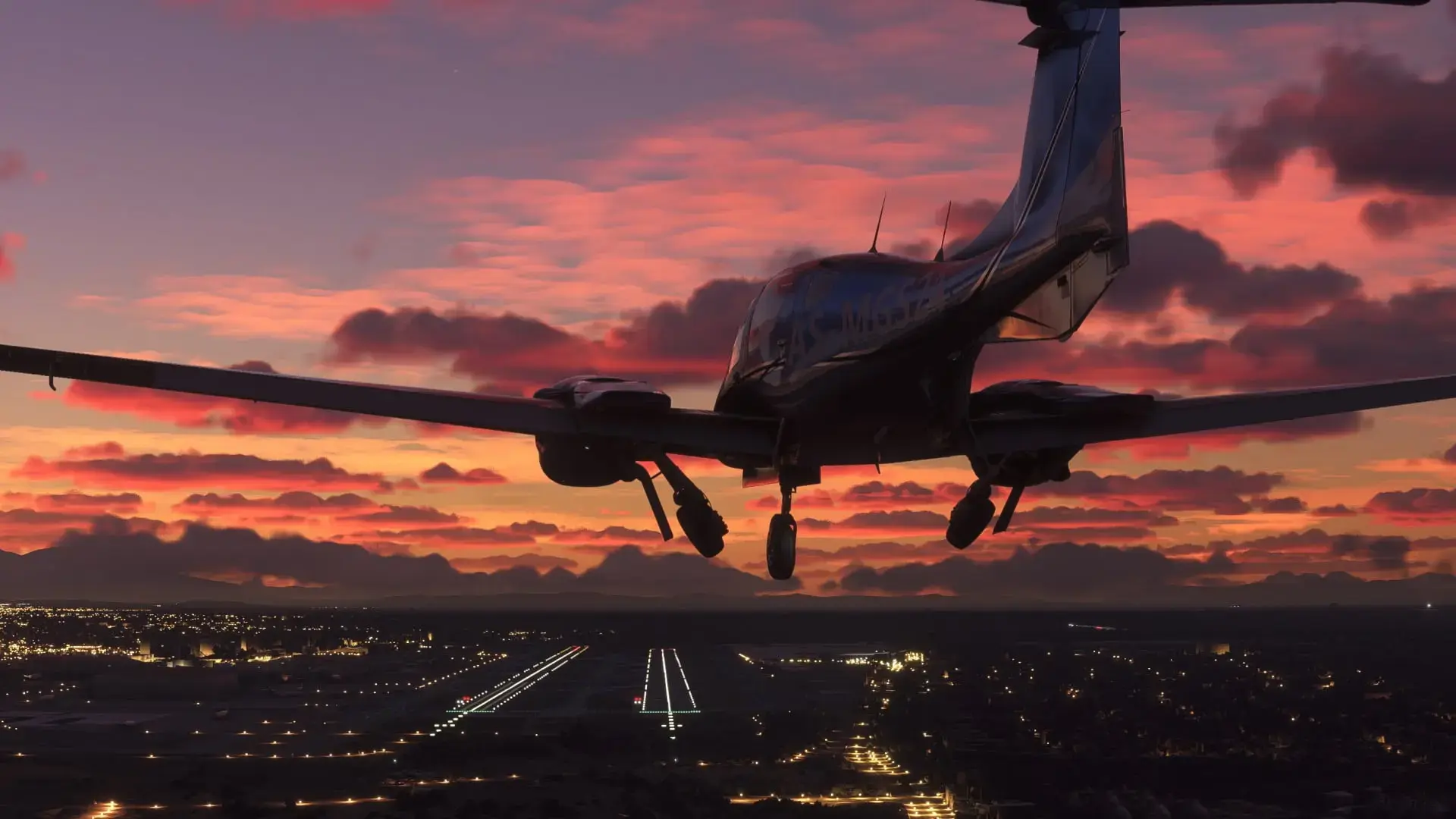The History of the Game Engine: Part 7 – Traversing the World
Modelling real-world environments with computers is the ultimate aim of many games and their engines, being worked on year after year on object physics, realistic graphics and atmospheric sound. Most games, however, allow a little bit of fantasy to go hand-in-hand with the realism—after all, isn’t it that stretch into the imagination what makes it a game?
Not necessarily so in the world of the flight simulator. Here, realism is everything and the ultimate goal—that of being able to train pilots—requires adherence to real-world conditions that most games simply never meet.
What does this mean for the humble game engine?
A Versatile Computer-Generated Dynamic Flight Display
In 1976, a young engineer called Bruce Artwick became known through a series of articles about simulating flight on computers using 3D graphics. Enthusiastic and driven, Bruce was a master of his topic, even using it as his degree thesis.
When pushed to prove his theory, Bruce stepped up to the task and the very first flight simulator was born.
Popular Products
It was a far cry from the complex systems we can access today, but Bruce’s early ‘versatile computer-generated dynamic flight display’ did more than just prove the theory, it wowed.
The response was enough to convince Artwick and his friend Stu Moment to form Sublogic Communications Corporation and create FS1 Flight Simulator for the Apple II in 1979.
Soon Microsoft was knocking on his door…
Microsoft Flight Simulator
In the early 1980s, 3D graphics were in their infancy. Elite, probably the most famous early example of 3D graphics in a game, was a few years away, and so the interest in Microsoft Flight Simulator (MSFS) was high. As was the concept—a game that allowed you to pilot a plane for hours? Was it a game? Did it have a purpose, an ending, a goal? The very idea was mind-boggling to many.
There were plenty who did get it though, and sales for Microsoft Flight Simulator were strong. Interestingly, the game’s engine was also getting some focus, but not for any obvious reasons.
Microsoft Flight Simulator was written in the early days of game development and its code was entirely independent of any operating system. Simply put, MSFS spoke directly to the IBM PC chipset without utilising MS-DOS (the prevalent operating system at the time) at all. Effectively, the game engine held its own operating system within it.

With more and more PC-based systems leaning on MS-DOS to provide them with basic functionality, this was an unusual move. But, it was needed to optimise performance and squeezing every ounce of power out of the computer without running anything extraneous.
One unintended consequence of this decision was that Microsoft Flight Simulator could sniff out a poor PC clone quite easily. Manufacturers building cheap IBM-PC clones at the time would test that MS-DOS worked, and thus, everything that used that operating system as a foundation, but MSFS and its near-unique bypass of the operating system would fail to function properly. Whether that was a good thing for the flight sim, as it could be used by companies to test the true compatibility of machines, or a bad thing, because it simply meant MSFS wouldn’t run on some computers, is a matter of perspective!
It showed one thing though that is true right to this day: if you want to simulate reality, then you are going to want to use the very latest technology and every resource that hardware offers.
Flight Simulator or Flying Game?
Anyone who has ever played the arcade classic Afterburner will doubtless agree that there is a vast world of difference between a flight simulator and a flying game. Afterburner stormed arcades in 1987, with its colourful graphics and fast-paced action, but it was as far from Microsoft Flight Simulator as could possibly be. This was a sprite-based game, that emulated 3D space through some cute zooming effects, not a vector-driven representation of reality.
Over time, however, the line is a lot less easy to see.
Fresh In
Microsoft Flight Simulator held its crown throughout the 1980s, where competitors such as Ace Combat Emulator (ACE) and F-29 Retaliator cared a lot more about the game aspect of the software than the simulation side, featuring combat scenarios rather than the pure civilian flying nature of MSFS.
The introduction of X-Plane in 1995 marked a change, however—here was a competitor playing in the same field.
Building a Flight Sim
So, what’s at the core of a flight simulator? Flight simulator game engines have one thing at the very centre of their ethos: a desire to be accurate and true to the real world. While most games are happy with approximations of reality, this simply is never enough for the flight simulator, where even the slightest touch has to be represented in the game with perfect precision. Users aren’t simply game-players looking to have a fun flight, but often seasoned professionals, looking to sharpen their skills and experience unusual and dangerous scenarios. For the developer, it’s a different mindset.
From the perspective of the game engine, this leads to an unusual situation; one where the requirements of the software simply outstrip the abilities of any package previously created. Where we have been discussing for some weeks in these articles the desire to not reinvent the wheel, that’s exactly what seems to happen here.
In the very early days, Bruce Artwick’s core engine ran in duplicate versions. Microsoft Flight Simulator, running only on IBM-PCs and their (technologically identical) clones. Artwick’s own company, Sublogic, was also developing a sister product in parallel—one that was open to using other machines such as the Apple line, and later the Amiga and Atari ST.
But since then, has there been much, if any, crossover in game engine similarity? In truth, the answer is ‘no’. Each company producing a flight simulator is doing so working from the ground up, painstakingly building the physics algorithms that are needed for such a complex task. This is an arena where subtle differences can make all the difference and why multiple flight simulators can co-exist.
It is also a place of community projects and devoted side-development. While Microsoft, and Laminar Research makers of X-Plane, protect their engine from prying eyes, others are running open-source projects. An example of this is FlightGear, which hope many brains can create the ultimate experience.
Will there be a time when standard engines such as Unity or Unreal will have the physics developed within them to make a flight simulation program truly viable? It’s possible, but their attention lies elsewhere. Modern game development is far more focused on impressive graphics and responsive gameplay than the fine nuances of rain on a wing.
Popular Products
Flying Through Reality
If you are going to simulate flight, it is an easy jump to suggest that you will also want to simulate the real world to fly over. Since the very beginning of flight simulators, work has been done to bring actual locations to the experience. For the first four decades, this has been a laborious job undertaken by passionate enthusiasts either on the development teams or individuals working to create plug-ins to enhance the core program.
Early versions of flight simulators would present ‘lifelike’ locations; models designed around landmarks, airports, cities and natural landscapes that were then rendered in-game and presented out of the plane windows. In the 1980s, these were as basic as the time and technology allowed, improved in the 1990s, and reaching a height in the 2000s and 2010s where the view was recognisable to anyone’s casual glance. It reached a peak, perhaps with X-Plane 11. The current version of X-Plane was released in November 2016 with real locations simulated and rendered with staggering levels of accuracy.
Close, but not perfect.
It falls, once more, to Microsoft. With their Flight Simulator 2020 release, a recent update to the genre after many years on the sidelines, Microsoft has merged technologies, combining the satellite and road-level world-mapping of companies like Google, GPS technology, and their own in-house development to provide a true real-world environment for their pilots. The results are incredible, showing just how far the humble flight simulator has come in 43 years.
Have they made a perfect flight simulator though?

Training Pilots
As mentioned earlier in the introduction, the ultimate goal for a flight simulator is to be good enough, immersive enough and accurate enough to actually simulate the real thing to the extent that it can train a pilot.
And it has been done.
X-Plane 11 has been certified by the FAA in America to allow users to complete their training using the software and help obtain a pilot’s license. You still have to log your real hours in real planes (40 hours for a private plane license), but all the training can be done from the comfort of your home.
Pretty impressive for a game.
Of course, it’s not just enough to get a copy of the X-Plane 11 software and install it on your home PC. In order to qualify for certification, you will also need the hardware that goes alongside it, which includes all manner of control systems and display panels to properly represent the inside of a plane cockpit. It’s expensive, for sure, with some items coming in at the £1,000 range, but it is possible, and probably a fun thing to show off to friends.
Fresh In
With Flight Simulator 2020, Microsoft doesn’t have that certification, despite it being a more modern program, with the real-world environments described above. This is due to a slight cut back on some of the finer controls. In short; Microsoft still sees their product as a game.
Playing at Flying
Want to shoot things down from the sky? Time has been good for arcade-enthusiastic pilots too, with games like Ace Combat 7: Skies Unknown providing a gaming experience that owes much to the hard work of the flight simulator developers. It might not be as ‘true’ a representation as X-Plane 11, but it’s damned good fun!
And it’s running on Unreal Engine IV.
Meanwhile, War Thunder, an online multiplayer take on vehicle combat that was born from a flight simulator, is another well-loved plane combat game. War Thunder uses the Dagon engine, a multi-platform proprietary gaming engine designed as a 3D and multiplayer engine by developers Gaijin. Though it may not have quite the polish of some of the top game engines today, its versatility is certainly impressive and War Thunder runs smoothly on any platform.
Both Ace Combat 7 and War Thunder show just how far the genre has come since the days of Afterburner!
Virtual Reality and Flight Sims
It would be remiss of me to discuss flight simulator engines without mentioning virtual reality. There’s something natural about how the idea of piloting a plane is ideal for a VR environment.
Both Microsoft Flight Simulator 2020 and X-Plane 11 support VR, allowing you to do away with multiple monitors and replace them with a single headset. Both are compatible with Oculus Rift and HTC Vive headsets for a fully immersive experience. War Thunder, too, works well with Rift and Vive systems.
Ace Combat 7: Skies Unknown will play nicely with PlayStation VR as does Ultrawings from Bit Planet Games.
It’s the tip of an iceberg, with VR still a technology that’s yet to really make waves in the mainstream, but it’s not too difficult for the game engines to support it, so developers do work with it in mind.
Popular Products
There are also flight sims with VR at their core. VTOL VR from Boundless Dynamics lacks some of the depth that can be found with other flight sims and air combat games, but with an engine that has been built from the ground up to focus on the VR aspect, it’s incredibly immersive.
The Future of Flight Sims
With their latest entry, Microsoft has shown just how impressive a flight simulator can be when paired with other technologies we use today. Real maps and GPS tracking make a huge difference to the absorbing quality of simulators like this. Will Laminar Research step up with the twelfth iteration of X-Plane? Of course they will.
And while giants such as these fight to make the flight simulation experience as true to life as possible, technological advances will filter through to the more commonly used engines. How long before Unreal incorporates real-time mapping and other advances? It’s not just the flight sim genre that would benefit from such things; with combat games and adventure titles all gaining from being able to be set in a real-world that’s 100% accurate.
Plus, as we start to see passenger flights to space, how long before there’s a true space shuttle simulator? Oh, wait! What’s this?
Next Time…
Guns. guns and more guns!
Guns are a big part of many games, but how did they go from Space Invaders shooting one bullet at a time to the armour-piercing, quick-reloading, firearms of today’s shooters? Join us as we find out.

